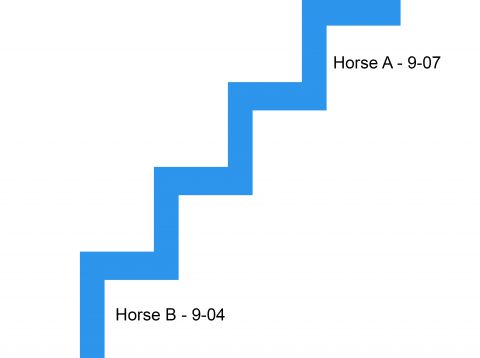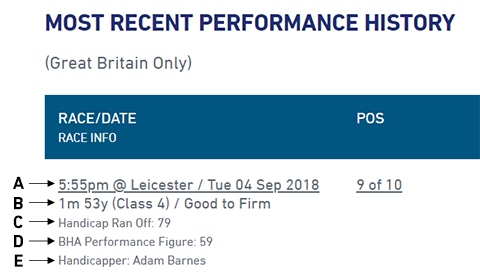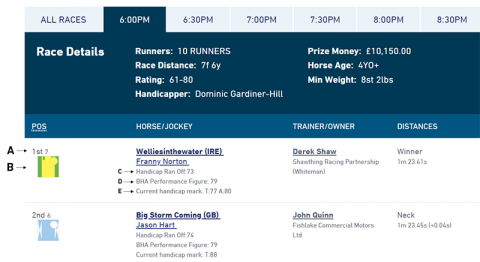Welcome to the BHA’s Guide to Handicapping. Here you will find all you need to understand how handicapping works in British racing.
If you do not find what you are looking for, please feel free to contact us.

Mission statement for BHA handicapping
Fair
Every horse will be treated fairly and with the highest level of integrity at all times, strictly on the merit of its form and using good handicapping practice.
Transparent
BHA Handicapping will be accessible and understandable for all customers. BHA methodology will be published, demystified and actively communicated.
Accountable
BHA Handicappers will be available to participants to provide logical and reasonable explanations for their decisions via the appropriate channels at the appropriate time.
Consistent
Using robust data analysis, the BHA Handicapping department will monitor and publish its work to ensure a consistent and equitable approach for all customer groups.
Progressive
The BHA Handicapping department will conduct research and analysis to ensure its policies are optimal in achieving a fair outcome for horses racing in British handicaps.
Why do we have handicap races?
Handicap races enable horses of varied ability to race competitively against each other via the allocation of weight. The higher their handicap rating, the more weight a horse is required to carry.
British racing welcomes horses with widely varying ability because they provide employment, enjoyment and entertainment for those who look after and own them. It is not merely elite horses that can produce an exciting race and the likely winner can be just as difficult – or easy – to work out for punters, whatever the class of contest.
But if a better horse were to repeatedly race against a lesser opponent at level weights, although other factors might on rare occasions distort the outcome, the better horse would usually win. This is the principle behind the elite Pattern class of racing, where horses compete on largely level terms to decide who is best.
Yet horses with less exalted levels of ability should have a chance of winning a race, too.
A handicap is the best way to provide this winning opportunity for most horses – and therefore a wider cross section of owners and trainers – because it enables those of varied ability to race competitively against each other with a realistic chance of success.
Handicap races are also proven to be a generally more attractive betting medium on account of their competitiveness
What is a handicap rating?
In essence a handicap rating is a numeric representation of a horse’s form and, therefore, its perceived level of ability at any given time.
 Imagine a long staircase in which every step is labelled with a number and ascends by one at a time. The higher the horse on the staircase, the better we think that horse is. We express this difference in ability in terms of weight therefore each step represents one pound (0.45 kilos).
Imagine a long staircase in which every step is labelled with a number and ascends by one at a time. The higher the horse on the staircase, the better we think that horse is. We express this difference in ability in terms of weight therefore each step represents one pound (0.45 kilos).
If Horse A’s current handicap rating is three steps higher than Horse B’s, we think those two horses would have a theoretically equal chance of winning a handicap race if Horse A carried three pounds more than Horse B e.g. 9 stone and 7lbs and 9 stone and 4lbs.
A handicap rating not only indicates the relative merit of any horse compared with another, but also provides some historical context with which to judge active horses against those that have raced in the past.
We revise and publish the handicap ratings for all currently active and qualified horses every week . On this website, you can look up any horse and any race for details about British form. You also have access to all of our current handicap ratings.
The below illustrations explain what each detail on the individual horse and results pages means.
Understanding horse annotation

A – Time, Course, Day and Date, Finishing Position and number of runners, Jockey, Weight, Prize Money won
B – Distance of the race, Class, Going
C – The handicap rating off which it ran in the race if it was a handicap
D – The Performance Figure assigned by the BHA handicappers
E – The BHA handicapper who assessed the race
Understanding result annotation

A – Finishing position, Racecard number, Name, Trainer, Distance beaten by the horse in front, Starting Price
B – Race colours, Jockey, Owner, Time taken, Time in seconds behind the horse in front
C – The handicap rating off which it ran in the race if it was a handicap
D – The Performance Figure assigned by the BHA handicappers
E – 5. The Current handicap rating T (Turf) A (AW) S (Steeplechase) H (Hurdle)
Once a horse has a rating, it is eligible to participate in handicap races. A horse’s handicap mark both guides – and greatly determines – which race a horse can (or should) contest. For example, a horse with a rating of 85 could not be entered in a handicap for horses rated 50-75 or for a classified race for horses rated 0-65.
We update our handicap ratings every Tuesday in order that a horse’s current rating is a fair reflection of its current form.
Who are the BHA's handicappers?
We are employed by the British Horseracing Authority to assess the form of its races and to allot and adjust handicap ratings for every horse that has been given a rating.
Each handicapper is assigned a core group of horses in order to accrue specialist knowledge about the horses and races within our divisions.
The BHA also employs a data analyst to inform and underpin our work with scientific analysis.
How do handicappers decide on a handicap rating?
When horses compete in any race, we take into account the weights carried and then decide which number best represents what they have each achieved. These numbers are called performance figures They are expressed on an identical scale to handicap ratings and demonstrate the merit of each individual performance.
You can access our performance figures in the BHA’s ratings database unless the horse is still unrated or the race is a maiden or novice. Horses usually need to achieve a minimum of three performance figures – that is, have raced at least three times – in order to for us to translate these into an initial handicap rating.
We produce performance figures for every horse in every race. Once we have completed this stage of the process, we then consider whether to allot an initial rating to a qualifying horse or to adjust the existing handicap ratings held by those horses that took part in each race.
See here to find out how handicap weights are determined.
See here for other tools the handicappers use to further illuminate the analysis of performance figures.
What races can my horse run in once it has a handicap rating?
Once a horse has a rating, it is eligible to participate in handicap races. A horse’s handicap mark both guides – and greatly determines – which race a horse can (or should) contest. For example, a horse with a rating of 85 could not be entered in a handicap for horses rated 50-75 or for a classified race for horses rated 0-65.
If a trainer believes a horse has a high level of ability, they might enter it in a Pattern race. Conditions and classified races provide less ambitious alternatives. Selling and claiming races also remain options. However, in Britain most horses run in handicap races for the majority of their careers.
We update our handicap ratings every Tuesday in order that a horse’s current rating is a fair reflection of its current form.
See here to find out what races a horse can run in before it has been given a handicap rating.
Can a trainer appeal against a handicap rating or refusal?
Yes. If a trainer believes we have not rated a horse fairly – or that we should not have refused a rating – then they can get in touch with the relevant handicapper to discuss it.
If the trainer is still unhappy, then they can follow the Appeal process.
Optional Claiming Handicaps
Optional claiming handicaps explained
Optional Claiming Handicaps are run as handicaps, but connections are able to claim a weight allowance off the horse’s handicap mark in return for the horse being claimable for an advertised claiming price, which will depend on the horse’s age and rating, but will be as prescribed in the table found here.
Horses are not required to be claimable, but, in this case, no allowance of weight can be claimed and the horse will be required to run off its current published handicap mark.
While the races will be open handicaps, it is envisaged that they will cater for horses running off a mark up to 105 and any horse rated above that will be permitted to enter, but will be required to carry the excess weight above 10st.
In order to illustrate how these races will work, a number of different scenarios are listed below.
Example 1
Horse A rated 105 is entered, but is not available to be claimed.
Horse A will run off a mark corresponding with a handicap mark of 105.
Example 2
Horse B is a 4yo, rated 105 and trainer wishes to claim the full 7lb allowance.
Horse B will run off a mark equivalent to 98 and will be claimable for £84,400.
Example 3
Horse C is a 4yo, rated 105 and trainer wishes to claim the full 7lb allowance; Horse C has won a race after the Saturday prior to closing, so incurs a 5lb penalty for that success.
Horse C will be claimable for £120,500 (equivalent to 105 – 7lb + 5lb = 103)
Example 4
Horse D wins an optional claiming handicap and runs in a standard handicap before his handicap rating has been reassessed.
Horse D will run off a mark equivalent to his advertised handicap rating plus the penalty applicable to that race.
Any further inquiries should be directed to the BHA’s Racing Department, email [email protected] or 020 7152 0050.
Schedule of Races
Date Racecourse Distance
10 July Yarmouth 6f
19 July Pontefract 1m
10 August Chelmsford City 6f
23 August Chelmsford City 1m
6 September Haydock Park 6f
13 September Sandown Park 7f
25 September Goodwood 1m
10 October Kempton Park 1m
22 October Newcastle 6f
26 October Doncaster 7f
Glossary of race types
Optional claiming handicaps explained
Optional Claiming Handicaps are run as handicaps, but connections are able to claim a weight allowance off the horse’s handicap mark in return for the horse being claimable for an advertised claiming price, which will depend on the horse’s age and rating, but will be as prescribed in the table found here.
Horses are not required to be claimable, but, in this case, no allowance of weight can be claimed and the horse will be required to run off its current published handicap mark.
While the races will be open handicaps, it is envisaged that they will cater for horses running off a mark up to 105 and any horse rated above that will be permitted to enter, but will be required to carry the excess weight above 10st.
In order to illustrate how these races will work, a number of different scenarios are listed below.
Example 1
Horse A rated 105 is entered, but is not available to be claimed.
Horse A will run off a mark corresponding with a handicap mark of 105.
Example 2
Horse B is a 4yo, rated 105 and trainer wishes to claim the full 7lb allowance.
Horse B will run off a mark equivalent to 98 and will be claimable for £84,400.
Example 3
Horse C is a 4yo, rated 105 and trainer wishes to claim the full 7lb allowance; Horse C has won a race after the Saturday prior to closing, so incurs a 5lb penalty for that success.
Horse C will be claimable for £120,500 (equivalent to 105 – 7lb + 5lb = 103)
Example 4
Horse D wins an optional claiming handicap and runs in a standard handicap before his handicap rating has been reassessed.
Horse D will run off a mark equivalent to his advertised handicap rating plus the penalty applicable to that race.
Any further inquiries should be directed to the BHA’s Racing Department, email [email protected] or 020 7152 0050.
Schedule of Races
Date Racecourse Distance
10 July Yarmouth 6f
19 July Pontefract 1m
10 August Chelmsford City 6f
23 August Chelmsford City 1m
6 September Haydock Park 6f
13 September Sandown Park 7f
25 September Goodwood 1m
10 October Kempton Park 1m
22 October Newcastle 6f
26 October Doncaster 7f
